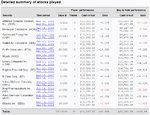the market is moved by a consenus of edges
Hey, kind of interesting what I did with the system above.
I summed up 4 different types of edges or more:
1) RSI ("extremely oversold")
2) Support/resistance
3) Moving averages ("some kind of confirmation or uncertainty with regards to previous trend")
4) "LONG only trades": knowledge that stocks go more up than down (that's why people say "Buy and hold" but not "sell and hold")
5) Stoploss and takeprofit: a specific approach to trading, which is not a given
The sum of these different "edges" seems to be profitable.
As I approached the markets in the past, I went through moving averages, pivots... all these things, and always said "hey, this thing doesn't work" or "this thing is unprofitable", and then I quit using them. I now realize how much the market is moved by a bunch of people like me, unprofitable and each trying to make money with their single edge: fibonacci, elliot, news, cycles, "my neighbour told me...", you name it. When all these people come together, or rather, when enough of these theories and trading methods, that alone might not be profitable, come together and agree, the market turns. I suppose one could build a system that weighs each edge with a value attributed to the edge which is simply a function of how many people use it, or rather how much that edge moves the market.
I often said "forget the news", "the news is useless"... wrong, of course. The news moves a lot of people. But probably the news alone will not make you profitable. The point is to be able to incorporate in your trading as many edges as you can compute mentally (in a correct way), because all these edges move people. A very elaborate automated system could definitely do this, but I am not capable of building it, so I am going to stick for now to my discretionary/automated systems based on just 3 or 4 edges, or better said, "ingredients".
Another way to achieve it and use all these edges together would be to gather 10 people using ten different edges (even better if 20), regardless of whether they're profitable or not, and ask them how they would trade and why. When there's a majority in favor, you can make the trade. Of course they could each be given different weight and so on, but you get my point. All edges are good, as long as you can weigh them correctly. And of course you can't say: I'll only make the trade if all edges agree, because then you might trade once a year or never.
I guess one simple way to do this is to spot, even on different forums, ten different users employing ten different edges, prolific users, who write posts all the time about their views on the market and their trades. Then you put all their links to their latest posts on one web page, and check it out as you're about to make a trade. These are the kind of users I would try to spot:
1) newbie trading just on news (doesn't matter if profitable or not) and mentioning them all the time (today this and that...)
2) elliot wave guy
3) support/resistance guy
4) pivot guy
5) fundamental analysis guy (long term fundamental trend) who comments about the economy
6) top and bottom picking guy (like me), who's always trying to pick a bottom and is always unprofitable
7) others I am forgetting...
8) and so on...
Actually this is exactly what I will do next, looking mainly on the trading journals across a variety of trading forums, such as elitetrader, this one and some others.







